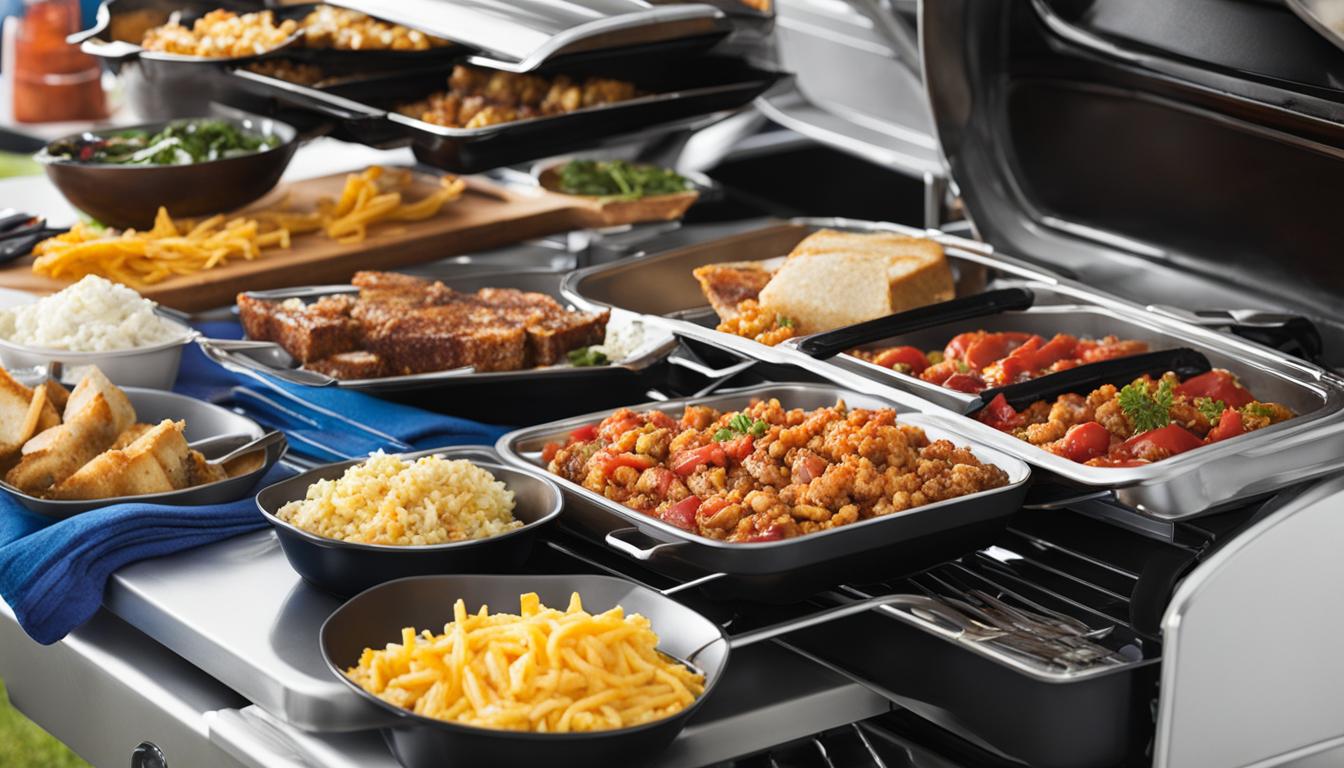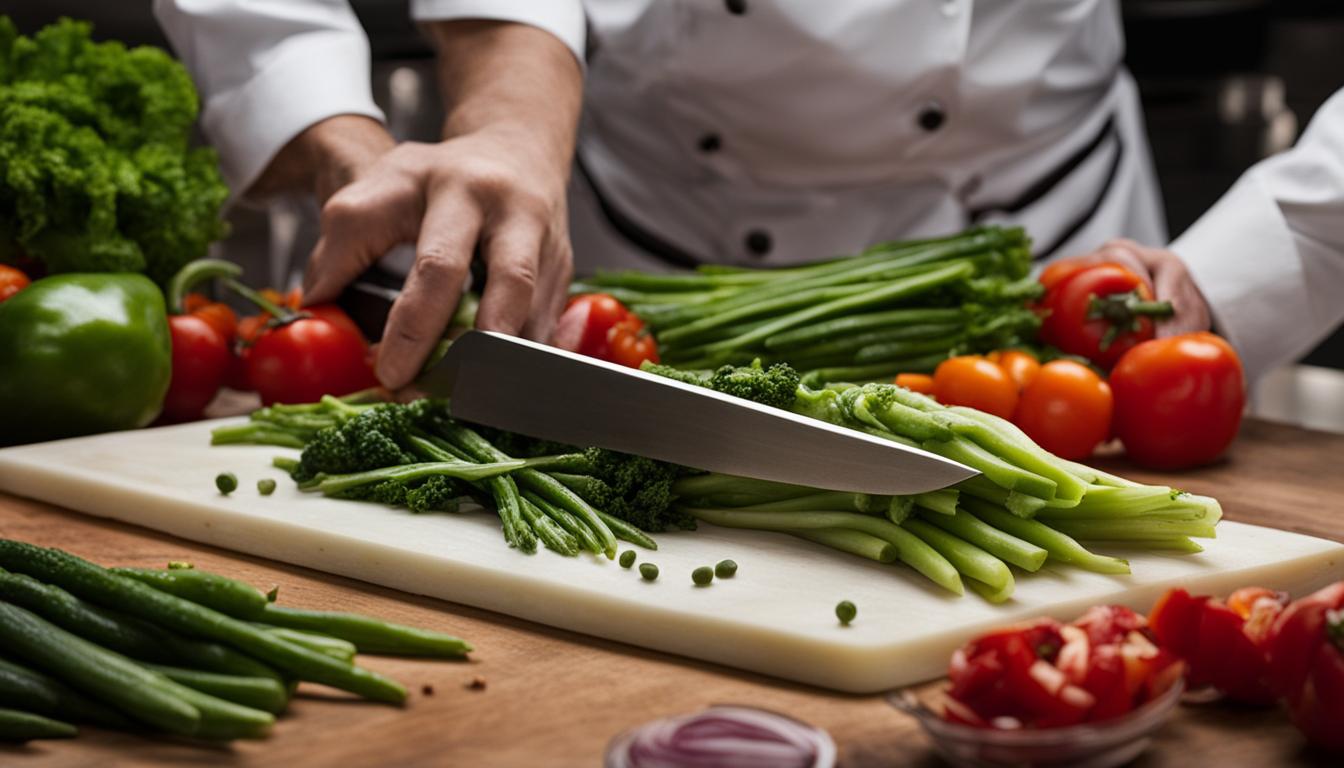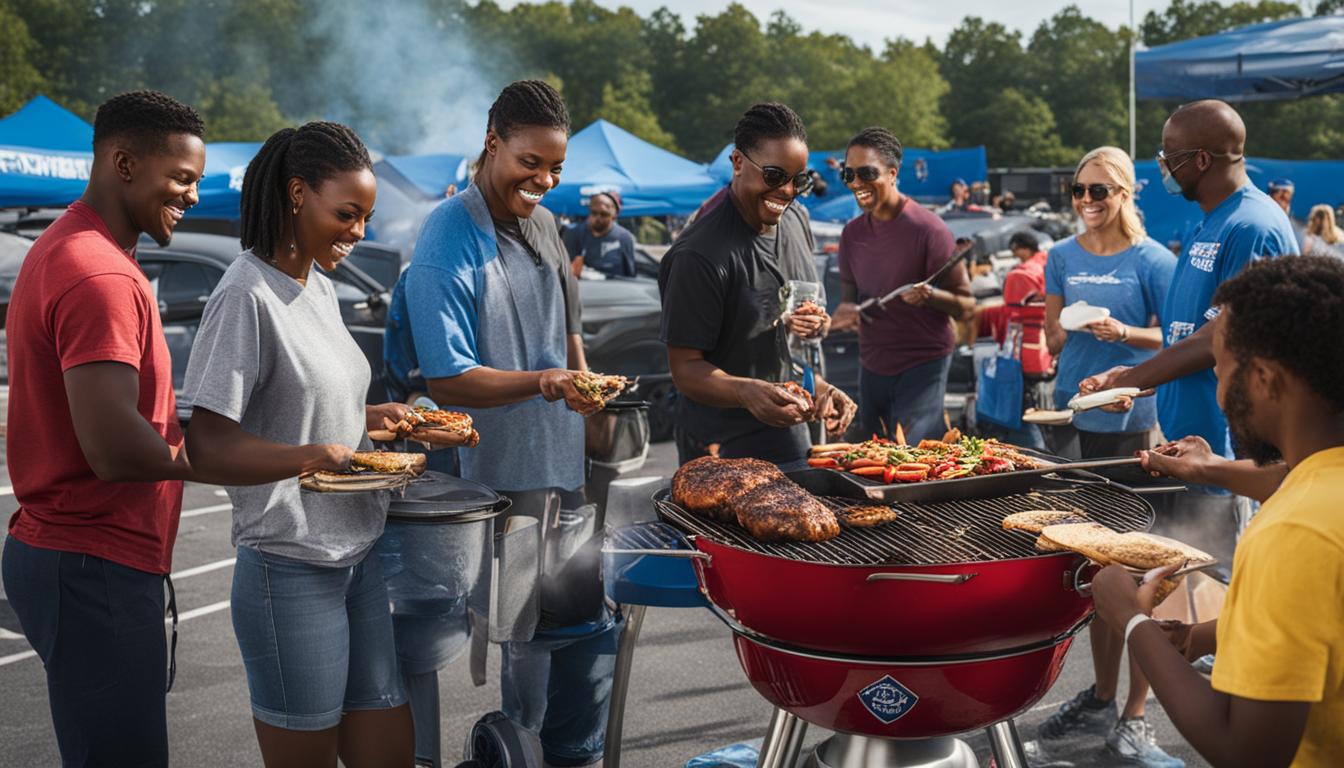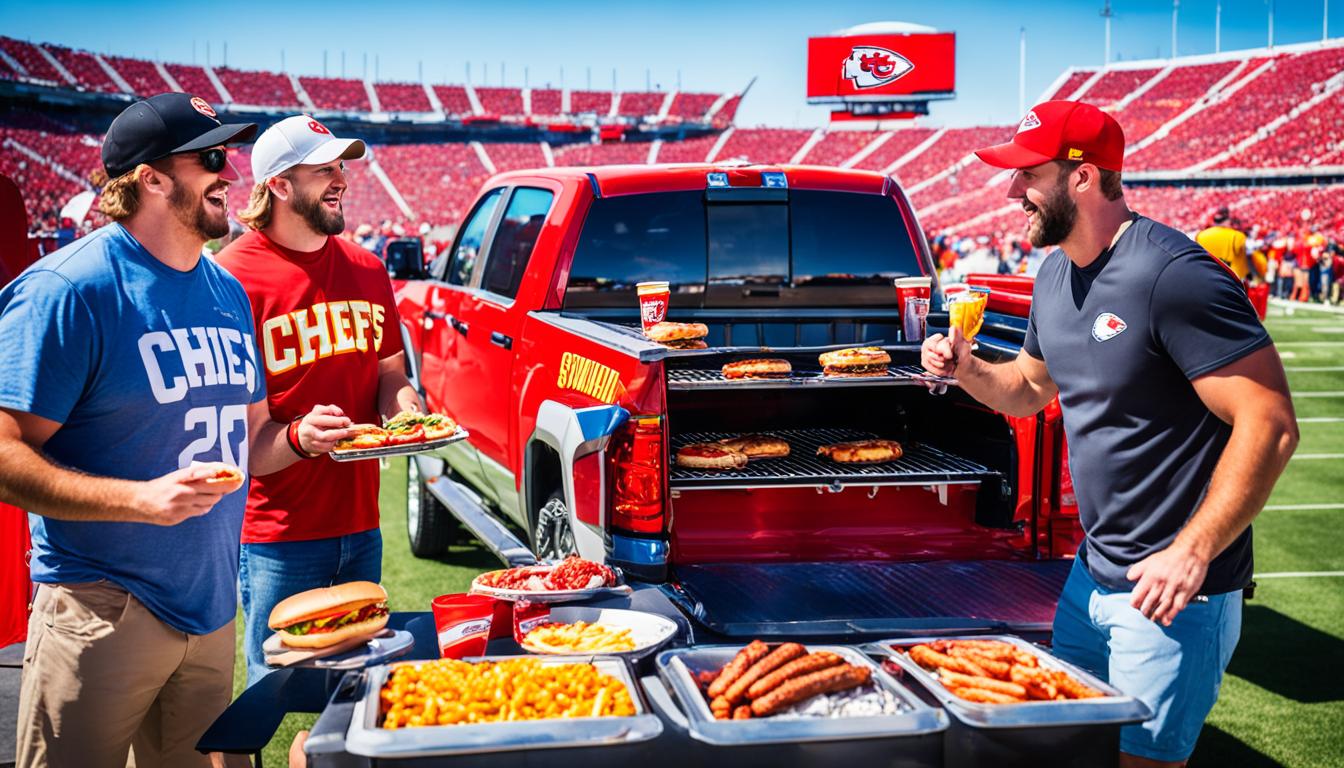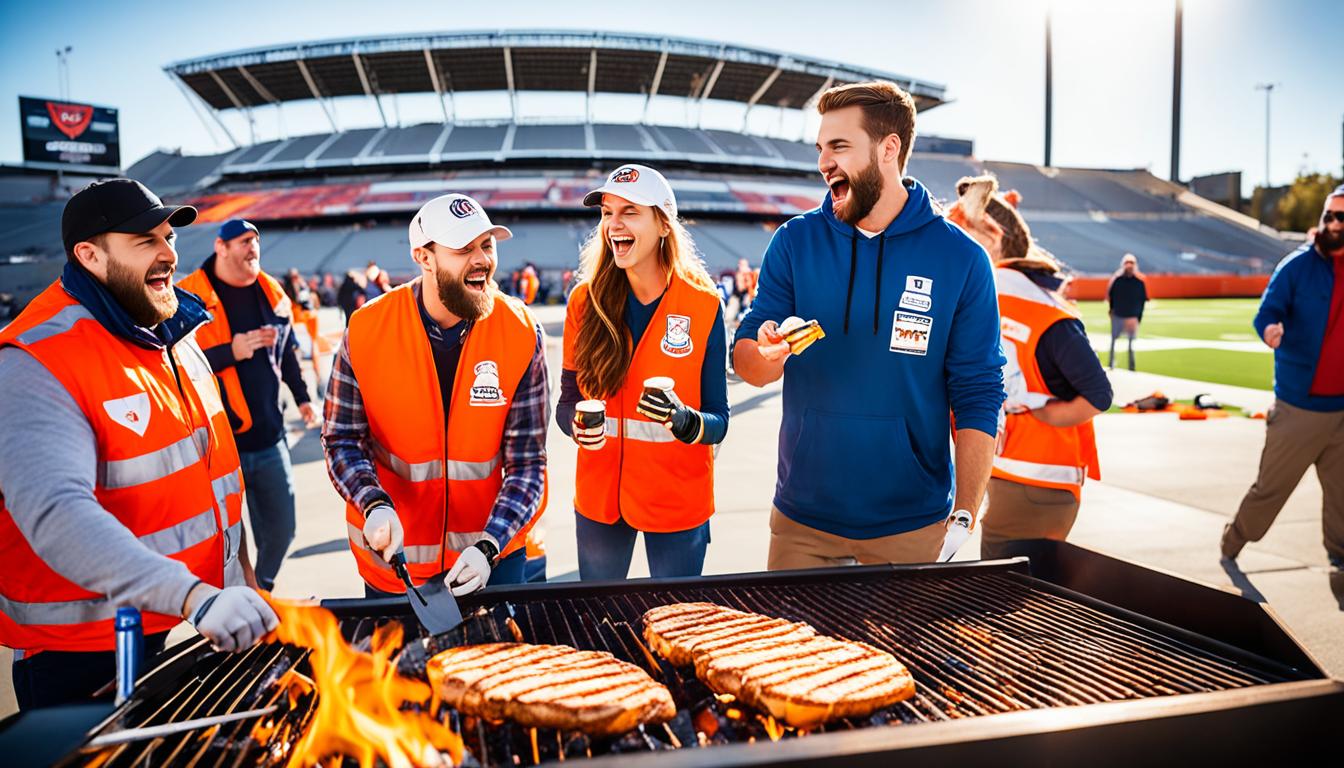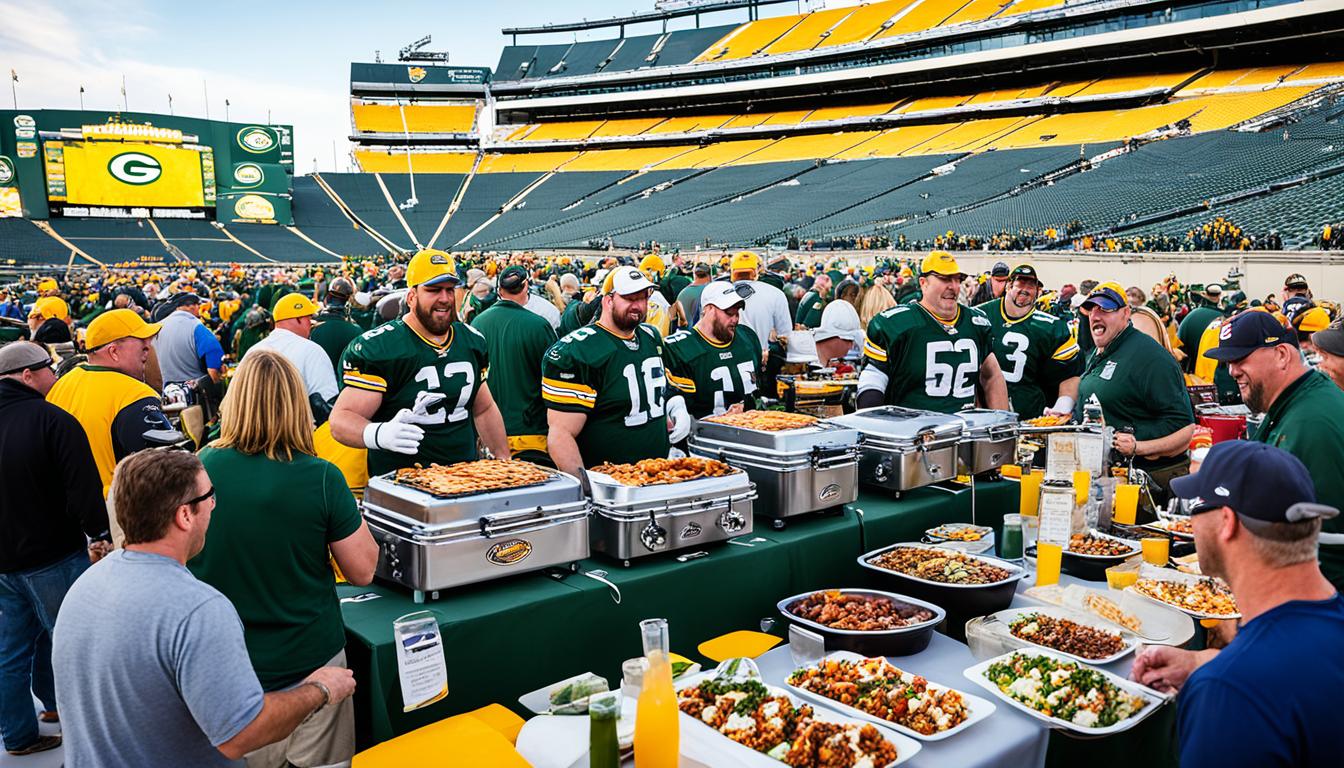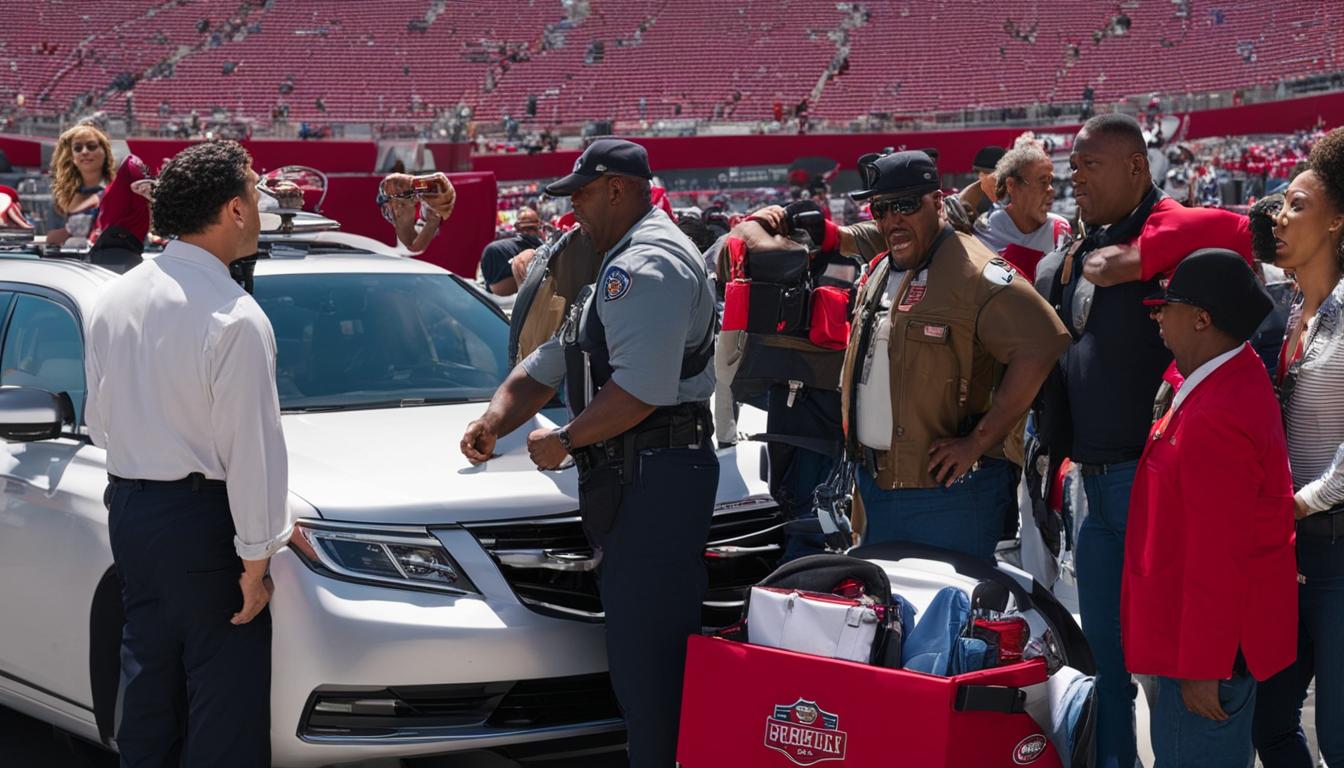Tailgate parties are a time-honored tradition for sports enthusiasts to come together, celebrate their favorite teams, and enjoy delicious food. While the excitement of the game can be contagious, it’s essential to prioritize food safety to ensure a memorable and safe tailgating experience for everyone involved.
From planning ahead to practicing safe food handling techniques, there are several key steps you can take to minimize the risk of foodborne illnesses and ensure that your tailgate party is a success. Let’s dive in and explore some essential food safety tips for your next tailgate gathering.
Key Takeaways:
- Proper planning is crucial to avoid last-minute food safety lapses
- Maintain proper food temperatures to prevent the growth of harmful bacteria
- Practice safe food handling techniques to minimize the risk of cross-contamination
- Promote good hygiene by providing hand sanitizers and wipes
- Label dishes to inform guests of common allergens
Plan Ahead for a Safe Tailgate
Thorough planning is crucial for a successful tailgate party. By taking the time to plan ahead, you can ensure a safe and enjoyable event. Here are some tailgate food safety tips and safe tailgating practices to help you get started:
- Create a checklist: Before the big game, make a list of the foods and beverages you plan to serve. Consider the number of guests and the duration of the event. This will help you determine the amount of food you need and avoid last-minute runs to the store. With a well-planned menu, you can also avoid rushed food preparation, which can lead to food safety lapses.
- Prep ahead of time: Preparing foods in advance can save you time and reduce the risk of foodborne illnesses. Cut and marinate meats the night before, refrigerate perishable ingredients, and pack non-perishable items such as condiments and snacks. This way, you can focus on grilling and enjoying the game without compromising food safety.
- Consider dietary restrictions: Take into account any dietary restrictions or preferences your guests may have. Plan to have options that cater to different tastes and accommodate common allergens like peanuts, gluten, or dairy. Labeling dishes will help guests make informed choices and avoid potential health risks.
Quick Tip:
Keep your checklist handy and refer to it on game day. This will help you stay organized and ensure that you have everything you need for a safe and delicious tailgate party!
Planning ahead sets the foundation for a successful and safe tailgate experience. With a well-thought-out menu, proper food preparation, and consideration for dietary restrictions, you can create a memorable event without compromising food safety.
Keep Food at Proper Temperatures
Maintaining proper temperature control is critical for food safety. It is important to prevent the growth of harmful bacteria that can cause foodborne illnesses. When it comes to perishable foods like meats and dairy products, keeping them at the right temperature is essential to ensure their safety and quality.
Perishable foods should be stored at a safe temperature of 40°F (4°C) or below. This can be achieved by using a reliable cooler with plenty of ice packs or ice. The cold temperature slows down the growth of bacteria, keeping the food safe for consumption. A food thermometer is also a valuable tool to monitor the temperature regularly, ensuring that it remains within the safe range.
Proper temperature control is crucial for preventing the growth of bacteria and maintaining food safety. It is essential to store perishable foods in a cooler with ice packs or ice to keep them at a safe temperature of 40°F (4°C) or below. A food thermometer should be used to monitor the temperature and ensure it stays within the safe range.
To illustrate the importance of proper temperature control, refer to the table below:
| Food Item | Safe Temperature | Danger Zone |
|---|---|---|
| Raw Meat | 40°F (4°C) or below | Between 40°F (4°C) and 140°F (60°C) |
| Dairy Products | 40°F (4°C) or below | Between 40°F (4°C) and 140°F (60°C) |
| Prepared Salads | 40°F (4°C) or below | Between 40°F (4°C) and 140°F (60°C) |
Image:
By properly storing perishable foods at the correct temperature, you can reduce the risk of foodborne illnesses and ensure the safety of your tailgate party. Remember to replenish ice packs or ice regularly to maintain the cold temperature and to use a food thermometer to monitor the temperature of the foods.
Practice Safe Food Handling
Proper food handling is vital to prevent cross-contamination and the spread of foodborne illnesses. By following these essential techniques, you can ensure the safety of your tailgate meals:
- Wash your Hands: Before and after handling food, thoroughly wash your hands with soap and warm water for at least 20 seconds. This simple step helps remove harmful bacteria and reduces the risk of contamination.
- Use Separate Cutting Boards and Utensils: Keep raw meats and ready-to-eat foods separate to prevent cross-contamination. Use different cutting boards, knives, and utensils for handling raw meats and other ingredients.
- Marinate Meats in the Refrigerator: If you plan to marinate meats, always do so in the refrigerator, not at room temperature. This helps maintain a safe temperature range and prevents bacteria growth.
- Cook Meat to the Recommended Internal Temperature: Use a food thermometer to ensure that meat is cooked to a safe internal temperature. This helps kill any harmful bacteria present. Refer to the following table for the recommended internal temperatures:
Here is a table of recommended internal temperatures for various meats:
| Meat | Internal Temperature |
|---|---|
| Chicken & Turkey (whole) | 165°F (74°C) |
| Chicken & Turkey (parts) | 165°F (74°C) |
| Ground Meat | 160°F (71°C) |
| Pork | 145°F (63°C) |
| Beef, Veal, Lamb (steaks, roasts, and fish) | 145°F (63°C) |
Remember, safe food handling techniques are crucial to protect yourself and your loved ones from foodborne illnesses. By implementing these practices, you can ensure a safe and enjoyable tailgate experience.
Promote Good Hygiene
Hygiene plays a critical role in ensuring a safe and enjoyable tailgate party experience. By prioritizing cleanliness and practicing good hygiene practices, you can reduce the risk of foodborne illnesses. Here are some tips to promote good hygiene at your tailgate party:
Provide Hand Sanitizers and Disposable Wipes
To encourage proper hand hygiene, make sure to provide hand sanitizers and disposable wipes for your guests. Hand sanitizers are convenient and effective in killing germs when handwashing stations are not readily available. Disposable wipes are handy for quick clean-ups and can be used to wipe down surfaces or equipment.
Consider Setting Up a Handwashing Station
If possible, consider setting up a designated handwashing station at your tailgate party. This will promote proper handwashing, which is essential for preventing the spread of bacteria and reducing the risk of foodborne illnesses. Include soap, water, and paper towels for thorough handwashing.
Keep Hands Clean
Encourage your guests to practice good hand hygiene throughout the tailgate party. Remind them to wash their hands before and after handling food, especially raw meats, as well as after using the restroom or touching surfaces that may harbor bacteria. Clean hands are one of the most effective ways to prevent food contamination.
“Proper hand hygiene is crucial in preventing the spread of bacteria and reducing the risk of foodborne illnesses.”
Regularly Sanitize Surfaces
Keep surfaces clean and sanitized by regularly wiping them down with disinfectant wipes or a solution of water and bleach. Pay extra attention to areas where food is prepared or served, such as countertops, cutting boards, and utensils. This will help minimize the risk of cross-contamination.
Encourage Guests to Practice Good Hygiene
Spread the message of good hygiene among your guests. Remind them of the importance of handwashing and encourage them to cover their mouths and noses when coughing or sneezing. Promoting good hygiene practices collectively ensures a safer and more enjoyable tailgate party for everyone.
By promoting good hygiene practices, you can create a clean and safe environment for your tailgate party, minimizing the risk of foodborne illnesses. Remember, clean hands and surfaces are essential in preventing the spread of bacteria and maintaining food safety.
Keep Hot Foods Hot, and Cold Foods Cold
When it comes to BBQ food safety, maintaining proper food temperatures is crucial. Hot foods should be kept at a temperature of 140°F (60°C) or above, while cold foods should be stored at 40°F (4°C) or below. By ensuring the right temperatures, you can prevent the growth of harmful bacteria and keep your guests safe.
For hot foods, consider using chafing dishes, warming trays, or even a grill to keep them at the ideal temperature throughout your tailgate party. These options help maintain the heat and ensure that your delicious dishes are safe to consume. Remember to check the temperature regularly with a food thermometer to guarantee food safety.
On the other hand, when it comes to cold foods, storing them in a cooler with ice packs is essential. The ice packs will help maintain a temperature below 40°F (4°C), preventing any bacterial growth. Keep the cooler well-sealed and regularly replenish the ice to ensure the foods stay cold and safe to consume.
To visually represent the importance of maintaining proper food temperatures, take a look at the table below:
| Food Category | Safe Minimum Internal Temperature | Maintain Hot Foods Above | Maintain Cold Foods Below |
|---|---|---|---|
| Poultry (chicken, turkey, duck) | 165°F (74°C) | 140°F (60°C) | 40°F (4°C) |
| Pork and veal | 145°F (63°C) | 140°F (60°C) | 40°F (4°C) |
| Ground meats (beef, pork, veal, lamb) | 160°F (71°C) | 140°F (60°C) | 40°F (4°C) |
| Fish and seafood | 145°F (63°C) or until opaque and flaky | 140°F (60°C) | 40°F (4°C) |
| Leftovers | 165°F (74°C) | 140°F (60°C) | 40°F (4°C) |
Table: Recommended internal temperatures and temperature ranges for different food categories.
By following these temperature guidelines, you can ensure that your BBQ is not only delicious but also safe to enjoy. Remember, food safety should always be a top priority when hosting a tailgate party.
Mind the Time
When it comes to food safety, time is of the essence. The two-hour rule for perishable foods is crucial in preventing foodborne illnesses. Perishable foods should not be left out at room temperature for more than two hours. However, if the temperature rises above 90°F/32°C, the time limit reduces to one hour. It’s important to adhere to these guidelines to ensure the safety of your food and protect yourself and your guests from harmful bacteria.
Leaving perishable foods out for extended periods allows bacteria to multiply rapidly, increasing the risk of foodborne illnesses. These illnesses can lead to unpleasant symptoms such as nausea, vomiting, diarrhea, and even more severe complications in some cases.
To avoid foodborne illnesses, be mindful of the time your perishable foods spend at room temperature. Remember to take into account the current temperature and adjust the time limit accordingly. After the designated time has passed, discard any perishable foods that have been left out to reduce the risk of contamination.
To keep track of time, try setting a timer or alarm to remind yourself when the two-hour mark is approaching. By being vigilant and proactive, you can prevent foodborne illnesses and ensure the safety of your tailgate party.
To illustrate the importance of the two-hour rule for perishable foods, take a look at the table below:
| Time | Temperature Range | Action |
|---|---|---|
| 0 minutes | Initial temperature | Food is safe and ready to be served |
| 60 minutes | Above 90°F/32°C | Time limit reduced to one hour for safety |
| 120 minutes | Between 40°F (4°C) and 90°F (32°C) | Food should be consumed or refrigerated promptly |
| 121+ minutes | Between 40°F (4°C) and 90°F (32°C) | Discard any perishable foods to prevent foodborne illnesses |
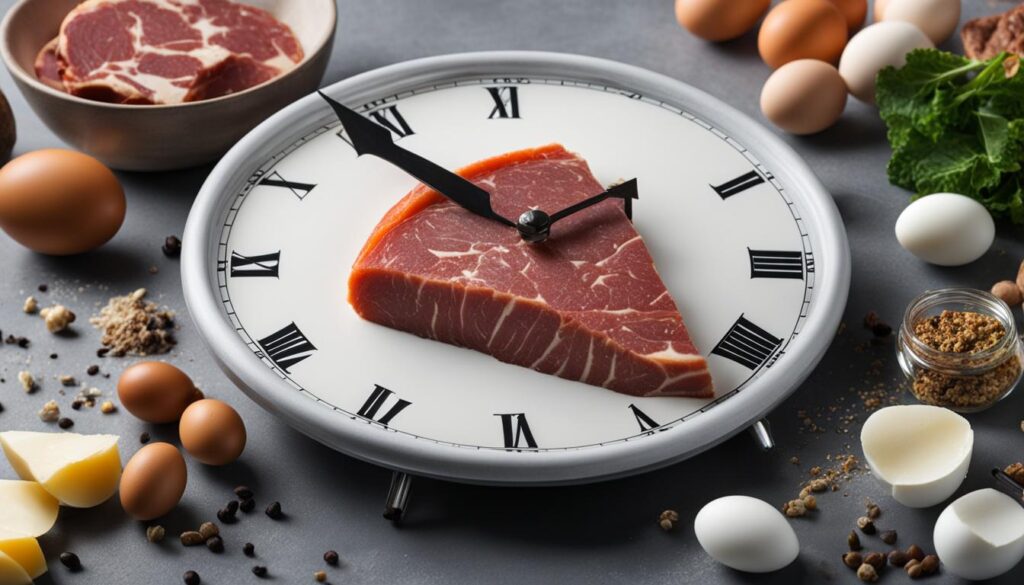
Label Allergens
If you’re hosting a tailgate party, it’s important to consider the dietary needs and allergies of your guests. Labeling dishes to indicate common allergens like peanuts, gluten, or dairy can make a big difference in ensuring everyone’s safety and enjoyment. By clearly informing guests of the ingredients and potential allergens in each dish, you empower them to make informed choices and avoid potential health risks.
When labeling allergens, be specific and concise. Use easy-to-read signage or small cards placed next to each dish. Highlight the key allergens present, and remember to update the labels if the ingredients change throughout the event.
By taking the initiative to label allergens, you create a safe environment for guests with allergies and demonstrate thoughtfulness and consideration. It also fosters a sense of inclusivity and shows that you value the well-being of all your party attendees.
Making Allergen Labels Clear and Effective
When labeling allergens, it’s important to keep a few key considerations in mind:
- Use clear, legible fonts.
- Ensure that labels are placed prominently next to each dish.
- Include all relevant allergens, even if they are not one of the “Top 8” allergens recognized by the Food and Drug Administration (FDA).
Here’s an example of an effective allergen label:
| Dish | Allergens |
|---|---|
| Chicken Skewers | Peanuts, Soy, Gluten |
| Vegetable Stir-fry | Soy, Sesame |
| Fruit Salad | Pineapple |
By clearly labeling allergens, you show your guests that their safety and well-being are a top priority. It’s a simple gesture that goes a long way in creating an inclusive and enjoyable tailgate party experience for everyone.
Handle Leftovers Properly
Preventing food waste and ensuring proper storage of leftovers is essential for maintaining food safety. Follow these tips to handle leftovers effectively:
- After your tailgate party, promptly store any leftover foods in small, shallow containers. This helps to cool the food quickly and evenly, reducing the risk of bacterial growth.
- Refrigerate the leftovers within two hours of cooking or serving. Keeping the food at a safe temperature will help prevent the growth of harmful bacteria.
- If you have large portions of leftover meats or dishes, consider dividing them into smaller portions before refrigerating. This allows for quicker cooling and easier reheating later on.
- Label the containers with the date before refrigerating to keep track of how long the leftovers have been stored.
- When reheating leftovers, make sure they reach a safe internal temperature of 165°F (74°C) to kill any bacteria that may have grown during storage. Use a food thermometer to ensure proper heating.
- If you can’t consume the leftovers within a few days, consider freezing them in airtight freezer bags or containers. Properly stored frozen leftovers can be enjoyed at a later time.
Remember, by properly handling and storing leftovers, you can reduce food waste and enjoy delicious post-game snacks or meals while ensuring food safety.
Stay Safe While Tailgating
When it comes to tailgating, prioritizing general safety is just as important as ensuring food safety. By following these safe tailgating tips, you can create a fun and safe environment for everyone:
- Avoid risky behaviors: While enjoying the festivities, it’s important to avoid risky behaviors such as playing games while consuming alcohol. Being mindful of other tailgaters nearby can help prevent accidents and injuries.
- Protect from the sun and heat: Remember to protect yourself and your guests from the sun and heat. Set up a shaded area where everyone can take breaks from the sun, and provide plenty of water and sunscreen. It’s also a good idea to wear hats and lightweight, breathable clothing.
- Consider alternative grilling options: Gasoline and charcoal grills can emit harmful pollutants into the air. Consider using electric grills or portable propane grills, which are safer alternatives that reduce air pollution hazards.
To further ensure a safe and enjoyable tailgating experience, keep in mind the importance of food safety as mentioned in the previous sections. By prioritizing food safety and general safety, you can create lasting memories without compromising anyone’s well-being.

| Tailgate Safety Tips | Summary |
|---|---|
| Avoid risky behaviors | Play games responsibly and be mindful of other tailgaters nearby |
| Protect from the sun and heat | Set up shaded areas, provide water and sunscreen |
| Consider alternative grilling options | Use electric or propane grills to reduce air pollution hazards |
Conclusion
Prioritizing food safety is essential for a successful and enjoyable tailgate party. By following these food safety tips for tailgating and incorporating healthy tailgate recipes into your menu, you can create a memorable experience while ensuring the well-being of your guests.
Planning ahead is key to avoiding last-minute rushes and potential food safety lapses. Make a checklist of the foods you plan to serve and consider the number of guests and duration of the event. This will help you shop and prepare food in advance, reducing the risk of cross-contamination and ensuring proper temperature control during the party.
Practice safe food handling by washing your hands, using separate cutting boards for raw and ready-to-eat foods, and cooking meats to their recommended internal temperatures. Promote good hygiene among your guests by providing hand sanitizers and disposable wipes, and consider labeling dishes to inform guests of common allergens. Lastly, handle leftovers properly by refrigerating them within two hours to prevent foodborne illnesses.
By prioritizing food safety and following these tips, you can create an atmosphere that not only supports your favorite team but also prioritizes the well-being of everyone attending your tailgate party. Have fun, enjoy delicious and safe tailgate meals, and make lasting memories with your friends and family.
Source Links
- https://caprockhealthsystem.com/5-tips-for-having-a-successful-tailgate-this-fall/
- https://ucanr.edu/blogs/blogcore/postdetail.cfm?postnum=57820
- https://www.premiofoods.com/strategies-make-next-tailgate-success/

Ryan Conlon is a passionate football fan and the driving force behind “Home Tailgate Party.” Ryan’s love for the game, combined with his culinary expertise, has led to a treasure trove of game day recipes and strategies. Whether you’re a seasoned tailgating pro or a rookie looking to up your game, Ryan’s insights and delicious recipes will help you score big at your next tailgate.

